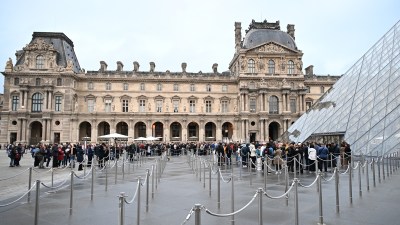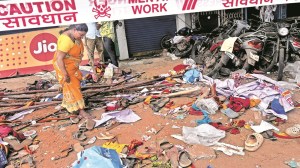Ghisingh back in the mountain mainframe
As Darjeeling votes in the West Bengal Assembly polls today, its biggest leader returns to the spotlight touting a controversial autonomy proposal

‘‘I am planning to write a book on Subash Ghisingh. It will be called ‘Ghisingh, an Enigma or a State agent?’’’. So said Kul Man Lama, one of the principal advisers to the Gorkha National Liberation Front president when the latter spearheaded a 28-month long violent agitation for separate state of Gorkhaland in the late 1980s. This was last autumn when the Darjeeling hills waited expectantly for the outcome of tripartite talks between Ghisingh, the Centre and the West Bengal government.
The GNLF leader himself was emerging in the political arena after a long hiatus. He had closeted himself after an assassination attempt on him in February 2001, thereafter attending only religious ceremonies and occasionally delivering long metaphysical speeches — and becoming more enigmatic than he ever was.
Ghisingh, pushing for the Sixth Schedule, was returning after talks with New Delhi when his convoy came under an armed attack in a desolate part of a highway in the hills. His political revival was timed with the Darjeeling Gorkha Hill Council election that was due March 2004, and he picked up the threads right away: he threatened not to allow the holding of the election, until the council was included in the Sixth Schedule. Finally, on 6 December 2005, a Memorandum of Settlement was signed between the Centre, state and Ghisingh, agreeing for the inclusion.
There is an irony to Monday’s polling in Darjeeling for the West Bengal Assembly elections. It is now more than two years that the election to Darjeeling Gorkha Hill Council is due; it is a year to this month that the hill panchayats have been “functioning” despite their term having expired. The entire system is in limbo, held hostage by one man.
Perhaps having been denied their franchise so far, the hill people are showing extra enthusiasm for Monday’s polls, as do the Opposition candidates. The CPI-M is the only national party in the fray but the main battle will be fought between the ruling Gorkha National Liberation Front and the anti-GNLF coalition Peoples Democratic Front; it will see the demand for autonomy, including the separate state of Gorkhaland, reverberate along the ridges.
The CPI-M would be satisfied in dividing Opposition votes in favour of the GNLF, given that bonhomie between the State government and Ghisingh has scaled new heights. The latter received his fourth extension from the government as “caretaker and sole administrator” of the DGHC in March.
By disavowing, for all practical purposes, the demand for Gorkhaland, Ghisingh has made himself the favourite of the State government. And Writers’ Buildings, in return, is ready to do anything to accommodate their trusted man — whether suspending elections or granting a carte blanche when it comes to administering the hills, including usage of monies.
The December MoS has all the makings of another protracted process that will long fester on the backburner of the national polity. The GNLF is pressing hard, touting the MoS as a major achievement towards autonomous rule in the hills, while the Opposition has dubbed the agreement a “Memorandum of Surrender.” There are fears that the proposal in its present form would balkanise the hitherto homogenous hill society.
The main controversy regarding the MoS centres on the composition of the 33-seat council: 10 seats for tribals, 15 seats for non-tribals, three for “all communities” and five to be nominated by the Governor.
It’s the first time the DGHC sees reservation based on ethnicity. Given that only Tamangs and Limboos among the Nepali-speaking are recognised tribals, while the majority — over a dozen other Nepali ethnic groups — belong to the General category, the latter are understandably unhappy and anxious over their fate once the MoS is implemented.
The ethnic fissures that are emerging among the Nepalese of the hills in the wake of the Sixth Schedule proposal is unprecedented. In the coming years, if the hill people continue to remain divided on tribal and non-tribal lines, an ethnic conflict, like the kind that occurred in the Sixth Schedule district of Karbi Anglong last October, cannot be ruled out. Local political observers are tempted to surmise that the Centre and the state, with the connivance of Ghisingh, are encouraging divisions among the hill people to undermine the demand for Gorkhaland.
The Sixth Schedule of the Constitution currently comprises special provisions for administration of Tribal areas in Assam, Meghalaya, Tripura and Mizoram. The governance of the autonomous district and regional councils instituted under the Schedule is carried out by an elected council. The Governor oversees it all. Tribal laws prevail in these councils while state laws are extended only after approval by the Governor. The council enjoys significant powers to legislate and impose taxes.
In contrast, the level of autonomy vested in the Darjeeling Gorkha Hill Council — set up in 1988 following a two-year-long violent uprising for separate statehood — is negligible. In several instances it has seemed farcical: even though vesting the DGHC with only executive powers, the government still failed to depute the required number of staff in various transferred departments. The Special Central Assistance of just Rs 22 crore annually amply reflects the position of DGHC on the priority list.
Prima facie the agreement to include the DGHC in the Sixth Schedule is a step up. Importantly, the DGHC would now find a place in the Constitution of the country. (Having been instituted under a State Act, the DGHC can be dissolved by the State Assembly without any recourse.) But the Sixth Schedule for the Darjeeling hills, as outlined in the MoS, has been greatly watered down and it is hard to believe that it would fulfill the political and economic aspirations of the hill people.
Tellingly, the MoS concludes that it “is the full and final settlement of the Darjeeling Hill Areas issue and no further demands in this regard would be entertained.”
Election campaigns of both the GNLF and the PDF have centred on the Sixth Schedule. The PDF, which includes All-India Gorkha League, Communist Party of Revolutionary Marxists, GNLF (C) and the BJP (a minor character in the alliance), has decided to oppose the Sixth Schedule in its present form. Their manifesto includes creation of Gorkhaland. On their part, the GNLF leaders are parroting Ghisingh’s claim that the Sixth Schedule is a better option than Gorkhaland.
The Sixth Schedule is a complex issue with a lot of political fodder. Sadly, it has caused the campaign to overlook other equally real and pressing issues like antiquated and broken infrastructure, unemployment and lack of enterprises, threatened environment, serious violation of democratic norms, and an endemic corruption. And also the arbitrariness of the elections itself when it comes to the hills.
(The writer is a freelance journalist based in Darjeeling)





- 01
- 02
- 03
- 04
- 05


























